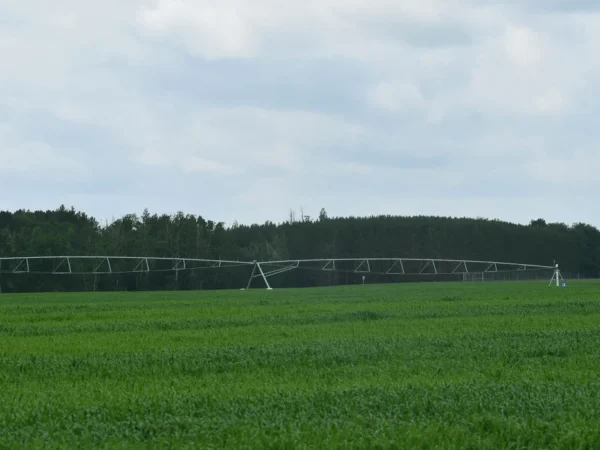
PFAS, short for per- and polyfluoroalkyl substances, are a group of widespread man-made chemicals that don’t break down in the environment or the human body and have been flagged as a major contaminant in sources of water across the country.
Keep up with PFAS-related developments in the Great Lakes area.
Click on the headline to read the full story:
Illinois
- PFAS lurking in Evanston water supply as U of Illinois researchers develop filter technology — ABC7 Chicago
According to a new analysis by the ABC 7 Data Team, at least 143 million Americans are possibly drinking, bathing and cleaning with tap water from water systems where some level of these chemicals has been detected.
- Measures to spotlight health risks from PFAS in firefighter gear close to becoming Indiana law — Indiana Public Media
Indiana is close to creating two laws that aim to draw attention to the health risks firefighters face from PFAS. These bills won’t remove potentially dangerous PFAS chemicals from firefighter clothing, but lawmakers and firefighter advocates hope it will be a step toward that.
- Dozens of Small Communities Drinking Water Contaminated with PFAS — Indiana Environmental Reporter
Thousands of Hoosiers could be drinking water contaminated with toxic PFAS potentially increasing their risk of developing cancer, liver damage and other health problems. Testing found 13 different PFAS chemicals in treated water from the systems, some at levels above those deemed safe by the U.S. Environmental Protection Agency.
According to Bridge Michigan, dozens of Michigan bodies of water currently have fish under PFAS contamination advisories.
- New PFAS pollution site found in Newaygo County — WOODTV.com
The site of a former sewage lagoon system has been identified as a PFAS pollution site by the Michigan PFAS Action Response Team.
- West Michiganders show PFAS levels twice as high than average, study reveals — WWMT
- Michiganders who drank PFAS have higher blood contaminant levels — MLive.com
- PFAS levels in West Michigan study are above national average, include extreme high-end … — WOODTV.com
Michigan Department of Environmental Quality tested high amounts of PFAS in the City of Parchment’s water system affecting thousands of households’ drinking water.
Minnesota
The Minnesota House passed the state’s largest-ever investment in natural resources and the environment, including legislation that prohibits PFAS. They can be toxic and are found in everyday products like cookware and cosmetics.
Ohio
- ‘Forever chemicals’: Eating the fish you catch can be harmful to your health — The Columbus Dispatch
Although the touting of Ohio fishing reasonably ramps up this time of year, like cigarette packaging it probably should come with a health warning.
- State Will Get $139 Million Federal Funds for Water Infrastructure — Urban Milwaukee
Wisconsin is set to receive around $139 million to upgrade drinking water infrastructure later this year, and more than half of that money will go toward replacing lead service lines.
- Wisconsin labels Tyco non-compliant in PFAS investigation. Here’s the latest in the dispute. — Milwaukee Journal Sentinel
- State regulators say Tyco is failing to comply with investigation of PFAS near farm fields — Wisconsin Public Radio
The DNR is once again listing Tyco as noncompliant after the company halted its investigation into PFAS on farms. Tyco previously discharged firefighting foam that contained PFAS to the city’s sewer system, and data from 2017 and 2018 showed the sewage sludge …
- DNR Seeking Public Input On PFAS Contamination In Marinette, Peshtigo And Surrounding … — Wisconsin DNR
The Wisconsin Department of Natural Resources is hosting two listening sessions on May 3 to share updates and seek public input on PFAS contamination in the city of Marinette, the town of Peshtigo and surrounding communities. These listening sessions are the 19th in a series of public input opportunities hosted by the DNR for area residents.
National
- Our sewage often becomes fertilizer. Problem is, it’s tainted with PFAS — WCAI
- Sewage often becomes fertilizer, but the issue is it’s tainted with PFAS — NPR
A lot of products contain toxic PFAS. Some of these “forever chemicals” are ending up in sewage that is turned into fertilizer.
- EPA Takes Important Step to Advance PFAS Strategic Roadmap, Requests Public Input and … — Environmental Protection Agency
Today’s announcement highlights EPA’s commitment to transparency and the use of the best available science to tackle PFAS pollution.
- Colorado School of Mines researchers patent new process to destroy harmful PFAS “forever … — CBS News
PFAS are called forever chemicals because of their tough durability and difficulty breaking down in the environment.
- How PFAS are entering America’s water supply — ABC News
PFAS are known to cause serious health issues and are seeping into America’s water supply, endangering millions of people who have been using the …
- Forever chemicals found disproportionately in poorer, more racially diverse US neighborhoods — ABC11
An ABC News analysis of reported PFAS water contamination found that 43% of U.S. ZIP codes have had at least one water source where PFAS contamination was detected over the past 20 years.
PFAS News Roundup: Questions about the EPA’s nationwide PFAS rule, answered
PFAS News Roundup: All fish tested from Michigan rivers contain ‘forever chemicals’, study finds
2 Comments
-
Thank you for providing an informative update on the PFAS (per- and polyfluoroalkyl substances) levels in West Michigan and the concerning finding that the levels are higher than the national average. The issue of PFAS contamination is of great concern and requires urgent attention to safeguard the health of both human communities and the environment.
The presence of elevated PFAS levels in West Michigan is a matter that should not be taken lightly. These persistent chemicals have been linked to numerous health risks and can have detrimental effects on both wildlife and ecosystems. It is essential that comprehensive measures are taken to address this contamination and prevent further spread.
I commend the efforts of organizations, government agencies, and communities that are actively working to monitor and mitigate the impact of PFAS contamination. It is crucial to raise awareness about the potential risks associated with PFAS and advocate for strong regulations to limit their use and release into the environment.
Additionally, the collaboration between different stakeholders, such as scientists, policymakers, and local communities, is vital in developing effective strategies for remediation and prevention. The sharing of information, like the PFAS news roundup you have provided, plays a significant role in keeping the public informed and engaged in the ongoing efforts to address this issue.
I encourage continued monitoring and research into PFAS contamination in West Michigan and other regions affected by this problem. It is through the combined efforts of scientific research, community engagement, and policy action that we can work towards cleaner and safer environments for all.
Thank you once again for shedding light on this important issue and for your commitment to raising awareness about PFAS contamination and its impact on the Great Lakes region.
-
I recently came across your article on the PFAS levels in West Michigan, and I wanted to express my concern about the situation. It is disheartening to learn that the PFAS levels in this region are higher than the national average. PFAS contamination poses significant risks to both human health and the environment, and it’s essential that we address this issue promptly and effectively.
The fact that West Michigan is experiencing elevated PFAS levels underscores the urgent need for comprehensive monitoring, mitigation, and remediation efforts. It is crucial to identify the sources of contamination and implement measures to prevent further pollution. Additionally, informing and engaging the affected communities is vital to ensure their voices are heard, and their health and well-being are safeguarded.
I commend Great Lakes Now for shedding light on this important issue and raising awareness among the public. Through responsible journalism and accurate reporting, you play a crucial role in advocating for solutions and holding relevant stakeholders accountable. It is only by working together that we can drive meaningful change and protect the health and integrity of our precious Great Lakes.
Furthermore, I encourage continued coverage of ongoing research, policy developments, and community initiatives aimed at addressing PFAS contamination. It is essential to keep the public informed about the progress being made, as well as the challenges that lie ahead. By sharing these stories, you empower individuals and communities to take action and contribute to the collective effort in combating PFAS pollution.
In conclusion, I want to express my gratitude to Great Lakes Now for your dedication to reporting on critical environmental issues, such as PFAS contamination in West Michigan. Your commitment to raising awareness and advocating for change is commendable, and I believe it will inspire others to get involved in protecting our precious water resources. Let us work together to ensure a safer and healthier future for the Great Lakes region.




